-

人教版新课标PEP小学英语四年级下册How Much Is It教案
一 教材分析本课时的主要语言项目是能够听说认读本课主要单词:colourful pretty cheap expensive并能运用句子:Its cheap/pretty/expensive/colourful.来描述价格和颜色。教材在Lets learn部分设计了一个小姑娘和妈妈谈论衣服的价格和款式的故事情景。在故事情境中自然的呈现了colourful pretty cheap expensive等词。通过小姑娘的话直观的引出了本课时的重点句型。Lets chant部分是给孩子提供了一个说一说的机会,让孩子在说一说中体会和巩固本单元的主要句型。二 教法建议1、本课时的语言项目可以和第三单元谈论衣物及第四单元描述天气两个话题话题很好的结合起来,教师在教学中可以从已学过的入手,在复习的过程总引入本课时的新知识,使孩子能把学过的语言结合起来进行运用。 2、学习Lets learn部分形容词colourful pretty cheap expensive时,教师让孩子看挂图或是尽量给孩子提供直观教具,让孩子对词汇有一个形象直观的感受。然后在教师和交流中自然的引出本课时的主句型Its cheap/pretty/expensive/colourful.来
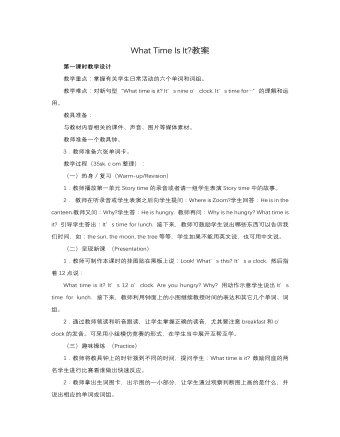
人教版新课标PEP小学英语四年级下册What Time Is It教案
2. 看图片或课件,回答理解性问题,并通过情景、动作等帮助学生理解hurry, ready 和oops的意义,可适当进行造句练习加以巩固,并注意对两个句型:“It’s time for ...”和“It’s time to ...”加以比较。听录音,然后跟读、模仿。分角色朗读和分角色表演。(三)趣味操练 (Practice)1.调查:设计一个调查表,然后调查五名学生或教师的作息时间,在四人小组中进行交流。鼓励学生用新句型“It’s time to ...”来表述。2.Let’s check教师连续播放三次录音。第一遍让学生先听录音,第二遍勾出与录音内容相符的一项,第三遍检查并核对答案。教师引导学生自我评价。(四)扩展性活动(Add-activities)1.做本单元B部分Let’s talk的活动手册配套练习。2.将本课时对话读给同伴、朋友或家长听。3.用英语向好朋友介绍自己的作息时间表。

人教版新课标PEP小学英语四年级下册Is This Your Skirt教案
【教学过程】热身/复习(Warm-up/Revision)free talkWhat color do you like?What color is your /…?Let’s chantB部分的Let’s chant.的歌谣,边说边出示单词。(二)呈现新课 (Presentation)观看Let’s learn部分录像,理解情景。教师带读生词,让孩子认读。小组比赛拼读,抽查孩子的拼读。两人一小组,一个拼,一个写。单词的抄写练习。出示句子的句卡,让孩子试读,教师提示学生注意第一个单词第一个字母大写,提示孩子注意标点和占格。模仿课文内容,学生自己设计对话,进行表演。(三)趣味操练 (Practice)拼一拼,猜一猜教师拼一个单词,让孩子迅速说出词孩子小组做游戏听一听,拼一拼每个小组一套字母卡片,请一个孩子说词,小组拼,比比谁最快。Pass the message教师分别给每个小组一张句卡,“What color is it? ”各小组抄写传到最后一名同学,写出答案。(四) 扩展性活动(Add-activities)设计你心目中的时装:每个孩子设计一套衣服,给自己的娃娃穿上,然后运用本单元学过的句子进行介绍。
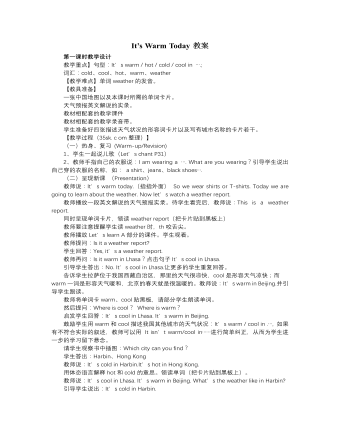
人教版新课标PEP小学英语四年级下册It’s Warm Today教案
1、Read and Write部分的课件及录音。 2、Pronunciation部部分的录音。 3、单词卡片:sunny,warm,cold,snowy,cool,cold, cloudy, hot, rainy, windy。 【教学过程 】 (一)热身、复习 (Warm-up/Revision) 出示单词卡:warm,hot,cool,cold,rainy,snowy,windy,sunny,cloudy,学生集体朗读。 请学生打开书P52,看记录回答教师问题: 教师提问:What’s the weather like in Beijing? What’s the weather like in Shanghai? 请4位学生分别提问Harbin,Lhasa,Urumqi,Hongkong的天气,大家回答。 请学生朗读P51对话后的句子:It’s cool. 在本上认真书写句子It’s cool. 教师要巡视检查。 (二)呈现新课 (Presentation) A. Lead-in 请学生继续看记录,教师提问: Is it warm in Beijing? Is it snowy in Harbin? Is it cool in Shanghai? Is it windy in Lhasa? Is it cold in Urumqi? Is it hot in Hong Kong? 引导学生根据记录用Yes, it is. 或No, it isn’t. 回答。 请学生用Is it…?分别猜一猜London,Sydney,Singapore,Moscow的天气,教师前一天根据天气预报情况用Yes, it is. 或No, it isn’t. 回答学生的提问。 请学生朗读P51对话后的句子:Is it cold?并说出意思。 学生在本上规范书写句子Is it cold?教师提示学生注意标点是?。
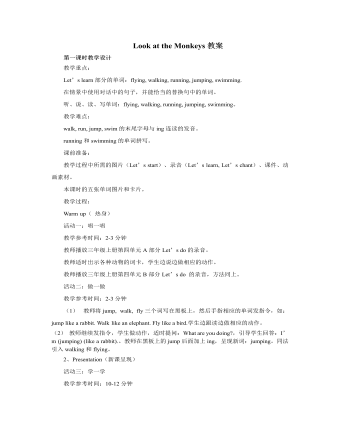
人教版新课标PEP小学英语五年级下册Look at the Monkeys教案
教学参考时间:5分钟(1)教师课前在教室里藏好一些动物和人物的图片。(2)给全班学生一分钟时间寻找。(3)请找到图片的学生根据图片上的人物或动物正在做的动作表演对话。活动七:猜一猜教学参考时间:5分钟(1)教师一只手拿一张图片,另一只手用白纸遮住图片,一边慢慢抽动白纸,一边问:What are the…s doing? 学生用They are…猜图片中的内容。(2)猜对的学生上台主持游戏。(3)教师也可以在白纸上剪几个圆洞盖在图片上,慢慢移动白纸的位置让学生猜白纸下面图片的内容。(4)也可以分组利用词卡做该游戏。4、Consolidation and extension (巩固与扩展)活动八:练一练教学参考时间:5分钟(1)活动手册Ask and write. 让学生看一看两个表格,找规律做问答,然后再把表格中所缺单词写出来。(2)活动手册Let’s find out.让学生仔细观察两幅图找出不同的地方,并用英语表达出来。活动九:小结教学参考时间:1分钟本课我们学习了如何询问他、她、它们正在做什么What are they doing? 及回答:They are…5、板书
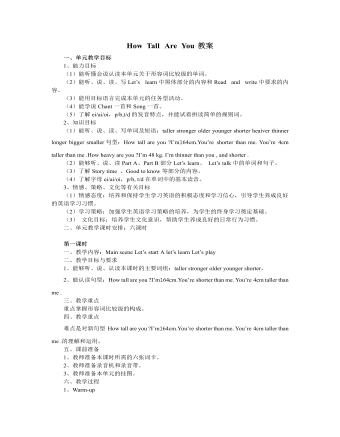
人教版新课标PEP小学英语六年级下册How Tall Are You教案
(1)呈现猴子图片,初步接触知识.教师在发指令时,加入 Touch your tail.当学生觉得茫然时,老师趁机出示课件(一只猴子)Look,We have no tails,but the monkey has.Look at the monkey,How long is the tail?在课件上呈现数据38cm.学生回答:Its tail is38cm long.根据教材内容教师提问:How tall is the monkey?学生:It’s 40cm tall.老师自己引出only一词,注意这个词的发音.多媒体再出示两只猴子的图片,一只黄色,一只棕色,让学生加以比较.教师问:Which monkey do you like?The yellow one or the brown one?【设计思路】 学生在回答这些问题时,也同时在复习前两课时所学内容,起到知识循环的作用.(2)猜一猜游戏:它们有多高?让学生猜一猜这两只猴子的身高.注意提示学生用上I think….这一句型,表示自己的猜测.在这里也可安排一个竞赛,看谁能猜中正确数据,教师让一些学生猜后出示数据.【设计思路】 学生对有悬念的东西都特别感兴趣,在此不仅练习了两位数的读法,又满足了学生的好胜心理.

人教版新课标PEP小学英语五年级下册Recycle1教案(内容详细)
学生搜集中外重要节日及部分中外名人的生日所在的月份。教师准备相关节日及部分中外名人的图片或音像资料片。教师课前准备Let’s find out2的配图画好春、夏、秋、冬四个方框。录音:Listen and number。教学过程:Warm up (热身)活动一复习单词教学参考时间:3分钟(1)教师播放Let’s chant部分的歌谣,学生听一遍后跟唱。(2)出示带有各个月份特征的单词卡片。学生看图说出单词,并一起拼读其缩写形式。帮助学生在有节奏的说唱中巩固记忆单词,为在后面活动中学生能够熟练应用作铺垫。活动二 复习句子教学参考时间:5分钟(1)师生同唱Let’s chant部分歌谣“When Is Your Birthday?”。(2)教师引导学生看歌谣下面的翻滚过山车的动画,师生进行问答,如:When is the rabbit’s birthday? It’s in May. 等。教师示范后请学生进行Pair work,也可以展开竞赛的形式进行“连锁问答”。巩固有关生日问答的语句,为Let’s find out1的活动做准备。

人教版新课标PEP小学英语五年级下册What Are You Doing教案
教学参考时间:2—3分钟教师让学生说出几个家庭成员名称,如:father, mother, sister, brother, uncle等,自己或让学生把单词写在黑板的一侧,再让学生说出几个动词短语的-ing形式,如:washing clothes, writing an e-mail, watching TV等,写到黑板的另一侧。学生在家庭成员名称和动词短语中分别选三至四个,自己编成一首歌谣。课后,可以让学生将创作的歌谣进行展示或举行歌谣朗读比赛。5、Consolidation and extension (扩展活动)活动十:知识扩展教学参考时间:1—2 分钟教师让学生打开书第54页Good to know 部分,了解主要国家的紧急救助电话。如:美国,英国,加拿大,澳大利亚等。教师还帮助学生了解我国的紧急救助电话号码。教师可以利用道具电话让学生做游戏。活动十一:练一练教学参考时间:2—3 分钟做本单元B Let’s talk部分的活动手册第37页的配套练习。教师讲解题目要求。教师播放录音,做Listen and number 部分练习。要求按所听内容在图上写出序号。再次播放,让学生按录音内容填空。鼓励学生自己读读所写句子。
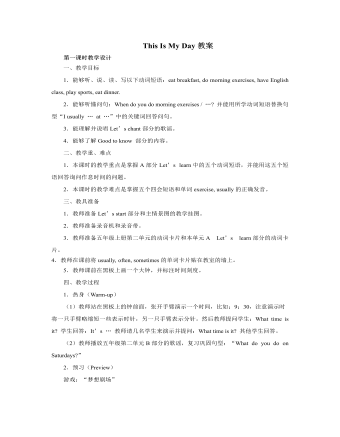
人教版新课标PEP小学英语五年级下册This Is My Day教案
学生初步了解对话内容,在描述中培养学生的语言运用能力。(2)教师让学生自己阅读本部分对话,不理解的生词和句子可以和同学或老师共同商讨。(3)教师帮助学生理解句子:“The weather report says it’s going to rain tomorrow. I can’t play football in the rain. I can’t go hiking, either. Let’s watch TV together.”出示图片:1) 晴天,Zoom在踢足球,图下显示:today;2)天在下雨,Zoom和Zip在屋里看电视,图下显示:tomorrow。与学生展开对话T:What’s the weather like today? S:It’s fine/ sunny. T:What does the weather report say about tomorrow?S:It’s going to rain.T:The weather report says it’s going to rain tomorrow.(呈现句子)(学生重复句子The weather report says it’s going to rain tomorrow.,并说出意思。)T:Can you play football in the rain?S:No,I can’t.T:Can you go hiking ?S:No,I can’t.T:In the rain, we can’t play football. We can’t go hiking, either. (呈现:either)学生跟读either,感悟单词的用法,教师讲解意思:(不......),也不...启发学生用either说两句话:In the rain, I can’t ... I can’t ..., either,从而在应用中巩固单词的读音和用法。
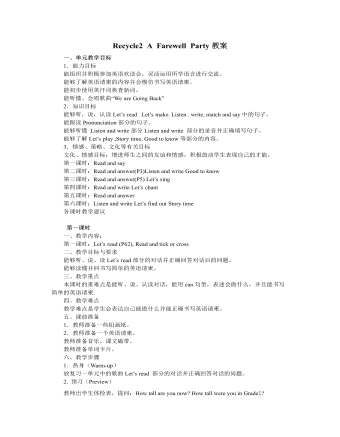
人教版新课标PEP小学英语六年级下册Recycle2 A Farewell Party教案
3. 新课呈现(Presentation) Let’s make (1)教师说:Miss White is making a book about her students. So she can remember them well.Who are the students? 请学生独立或分小组朗读四段短文,解释学生不理解的句子,然后说:There are four pictures below. Would you like to help Miss/White glue the pictures? 教师知道学生完成图文搭配的练习。 (2)教师发给每名学生一张铅画纸,说:Now please draw a picture of your best classmate. Then describe him or her.学生画一副最要好的同学的肖像,并在傍边配上对该同学的英语介绍。 学生上讲台介绍自己最要好的同学,请其他学生猜是谁,看谁说的生动又贴切,教师给予评价时注意强调第三人称单数形式的使用。 Story time 教师向学生展示Story time部分的教学挂图,指着最后一副图中的Zoom 和 Zip说 Look at the picture. Zoom and Zip are sad. They are saying goodbye to each other. Now let’s see What happened. 学生同桌之间合作阅读或是,然后教师提出问题Where is Zip going? Is this good news for zoom ? What grade is Zip going to be in? 教师放录音,学生录音跟读故事,然后再分角色朗读.

人教版新课标PEP小学英语六年级下册What’s the Matter, Mike教案
回答:She’s sad. She failed the math test.并板书:fail the math test。准备一张很糟的数学试卷,是学生了解语意。进一步教学其他短语a Chinese test, a English test,并 让学生了解pass the Chinese test, pass the English test, pass the math test. (4)教师请学生扮演Sarah,师生对话如下: T: Hello! Sarah, how are you? You look sad today. Sarah: Yes, I failed the math test. 教师接着说:I’m sorry to hear that.让学生理解意思。并引申出句子:I’m glad to hear that.让学生分角色朗读对话。 (5)Let’s check.让学生看Sarah的表情,并读两篇对话,选出正确的答案。 (6)活动名称:心理医生 活动目的:操练句型“How are you? You look…”.学生间自由组合编排对话.通过对话对学生展开情感教学,让学生理解健康的体魄和愉悦的心情的心情是一个人成功的重要因素,使学生形成良好的心理健康状态。 活动过程:A: How are you? You look bored today. B: Yes. I failed my math test. A: I’m sorry to hear that. Believe yourself. Work hard. You can pass the text next time. (7)活动名称:难忘时刻 活动目的:围绕照片上的表情展开询问和讨论.操练句型 “How do you feel? How does she/he feel?

人教版新目标初中英语七年级下册Don’t eat in class教案2篇
Don’t fight. =You can’t fight. (板书,教读)教师把这些句子板书在黑板上,并请学生大声整齐地读祈使句和“can’t”句型,并让学生注意两种句型表达形式的不同和转换,“Don’t …=You can’t…”;并对学生说:These are our school rules. (板书,教读) You can’t break the school rules. Don’t break the school rules.(板书,教读)步骤3 :Practicea. T: Now, each of the students is breaking one of these rules.Please finish 1a.学生看图,完成1a的内容,检查答案并大声朗读校规。b. 听录音,完成1b,选出四位学生都违反了哪条校规;听之前,学生要读会英文名。c. 请两位学生朗读1c部分的句型;要求学生两人一组对话表演,SA扮演外校转来新生,SB告知本校校规。(学生可经过讨论,多说出他们想到的校规,不必只限于书上;教师应给予帮助)2) 第二课时(2a~4)步骤1 :warming up of revisionT: What are the rules at your school?学生使用“can”或祈使句表达各条校规;其中老师可引出“eat in the cafeteria outside”的表达。步骤2 :Practicea.T: Christina is an exchange student. She doesn’t know the rules. Let’s listen, what activities they’re talking about?学生听第一遍时,完成2a;第二遍时,完成2b;b. 请学生领读2c部分,看着2a完成的表格,理解2c活动的要求;分成小组针对2a进行问答;
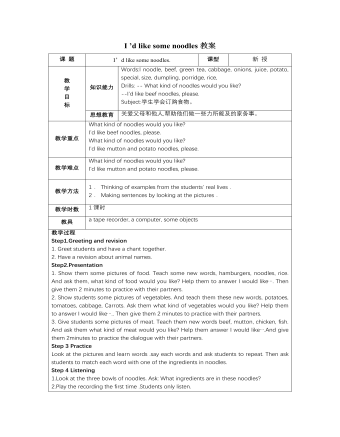
人教版新目标初中英语七年级下册I ’d like some noodles教案
教学过程Step 1: warming-up Sing a song---------“food and drink” Step 2: Revision1 Dictation2 Revise: What kind of noodles would you like?I’d like …What size bowl of noodles would you like?I’d like…Step 3: Presentation1 show pictures of food, ask students say the words.2 Students read the newspaper ad in 3a. Fill in blanks with words in the box. Then read the ad together, the teacher explains some difficult language points.3 Check the answers Step 4 PracticeAsk students to finish 3b in the same way according to 3a. Students read the short passage and fill in the blanks .At last, check the answers.Step 5 productionAsk students to write their own ad for dumplings, noodles, drinks, and other foods they know. Then ask students to read their partner’s ad. Then order food and drink from their partner.Step 6 Home workGroup work – make an ad about “food and drink”
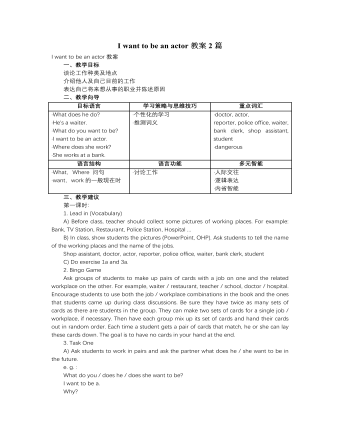
人教版新目标初中英语七年级下册I want to be an actor教案2篇
三、教学建议第一课时:1. Lead in (Vocabulary)A) Before class, teacher should collect some pictures of working places. For example: Bank, TV Station, Restaurant, Police Station, Hospital ...B) In class, show students the pictures (PowerPoint, OHP). Ask students to tell the name of the working places and the name of the jobs.Shop assistant, doctor, actor, reporter, police office, waiter, bank clerk, studentC) Do exercise 1a and 3a.2. Bingo GameAsk groups of students to make up pairs of cards with a job on one and the related workplace on the other. For example, waiter / restaurant, teacher / school, doctor / hospital. Encourage students to use both the job / workplace combinations in the book and the ones that students came up during class discussions. Be sure they have twice as many sets of cards as there are students in the group. They can make two sets of cards for a single job / workplace, if necessary. Then have each group mix up its set of cards and hand their cards out in random order. Each time a student gets a pair of cards that match, he or she can lay these cards down. The goal is to have no cards in your hand at the end.3. Task OneA) Ask students to work in pairs and ask the partner what does he / she want to be in the future.e. g. :What do you / does he / does she want to be?I want to be a.Why?Because it's (adj).B) Vocabulary: Section B, 1a4. Homework 1.2.
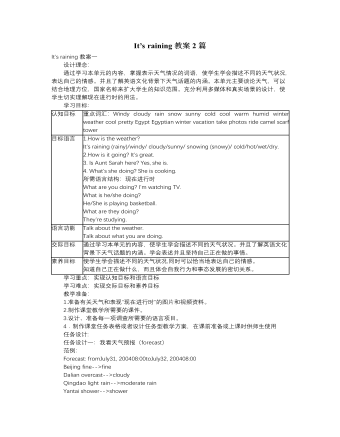
人教版新目标初中英语七年级下册It’s raining教案2篇
1 Each group choose one place to describe and what you are doing in it Choose one place, and describe what they are doing 2 Move around the room and give suggestions Talk about it and write it down 3 Ask one to show their works and act it Choose one of each group to make a report 4 Evaluate the best group and the best reporter Choose the best one Homework Ask your friends their ideal place and write about it教学反思:新课程标准中强调学生在课堂中的主体地位,在综合课中他们的主体地位就更加突出。在各个活动中给不同程度的学生不同层次的任务,让各层面的学生都有表现发挥的机会,从而产生对英语的兴趣。使用照片图片多媒体来辅助教学,效果更好。同时让了解其他国家风景,风俗的同学介绍ideal place,增加学生的背景知知识,实现跨学科交流的目的。教案点评:采用任务型教学模式,在各个活动中给不同程度的学生不同层次的任务,让各层面的学生都有表现发挥的机会,从而产生对英语的兴趣。使用照片图片多媒体来辅助教学,效果更好。让了解其他国家风景,风俗的同学介绍ideal place,增加学生的背景知识,实现跨学科交流的目的。
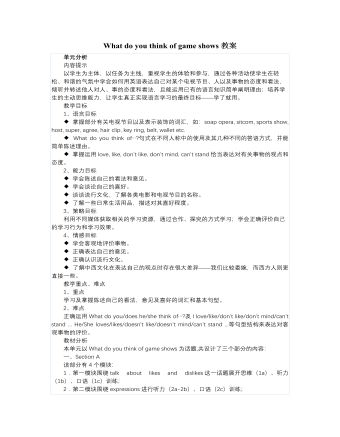
人教版新目标初中英语七年级下册What do you think of game shows教案
五、教学Section B-2c1. Pair work: What do you think of the belt/sunglasses/…? What does your father/mother/… think of your scarf/belt…?2. Group work(1). Teacher shows some different kinds of school uniforms (制服)and asks : “ What do you think of your school uniforms? If you have a chance to choose your school uniforms, what kind would you like to choose?”(2). Discuss in groups.(3).Get some Ss to report in class.说明:这一步旨在让学生运用已有的语言知识谈论对事物的看法和意见,并简单阐明理由,培养学生的主动思维能力和运用英语的能力。六、教学拓展调查电视节目的收视率任务:调查你周围的人对现在各种电视节目的反响。活动过程:1.教师布置任务,让学生调查周围的人(包括他的亲戚朋友和邻居)喜欢收看哪方面的电视节目。2.学生进行调查活动,运用本单元所学的句型What do you think of….? (Why?)What's your favorite game shows?What do you think of talk show?I doesn’t mind it.I like it.I love it.I can’t stand it.3.记录下排在前10位的TV Program,填写调查表,比较其收视率。
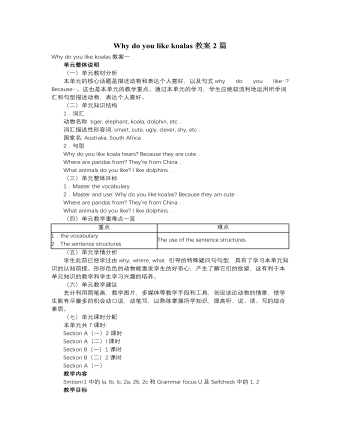
人教版新目标初中英语七年级下册Why do you like koalas教案2篇
单元整体说明(一)单元教材分析本单元的核心话题是描述动物和表达个人喜好,以及句式why do you like…? Because…。这也是本单元的教学重点。通过本单元的学习,学生应能较流利地运用所学词汇和句型描述动物,表达个人喜好。(二)单元知识结构1.词汇动物名称 tiger, elephant, koala, dolphin, etc.词汇描述性形容词: smart, cute, ugly, clever, shy, etc.国家名: Australia, South Africa2.句型Why do you like koala hears? Because they are cute.Where are pandas from? They're from China.What animals do you like? I like dolphins.(三)单元整体目标1.Master the vocabulary2.Master and use: Why do you like koalas? Because they am cute.Where are pandas from? They're from China.What animals do you like? I like dolphins.(四)单元教学重难点一览(五)单元学情分析学生此前已经学过由why, where, what 引导的特殊疑问句句型,具有了学习本单元知识的认知前提。形形色色的动物能激发学生的好奇心,产生了解它们的欲望,这有利于本单元知识的教学和学生学习兴趣的培养。
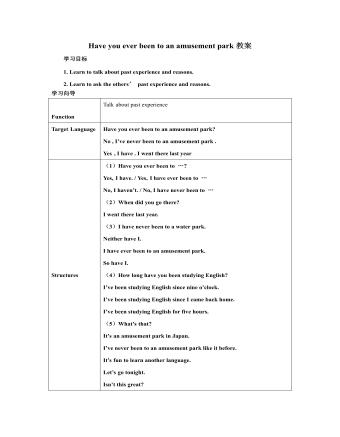
人教版新目标初中英语八年级下册Have you ever been to an amusement park教案
(1)Have you ever been to …? Yes, I have. / Yes, I have ever been to …No, I haven’t. / No, I have never been to …(2)When did you go there? I went there last year. (3)I have never been to a water park. Neither have I. I have ever been to an amusement park. So have I. (4)How long have you been studying English? I’ve been studying English since nine o’clock. I’ve been studying English since I came back home. I’ve been studying English for five hours. (5)What’s that? It’s an amusement park in Japan. I’ve never been to an amusement park like it before. It’s fun to learn another language. Let’s go tonight. Isn’t this great?space museum, amusement park, water park, South America, Peru, Holland, European culture, tour guide, flight attendant, musical instrument, more than, be from, get to, take lessons, neither, discover, graduate, change
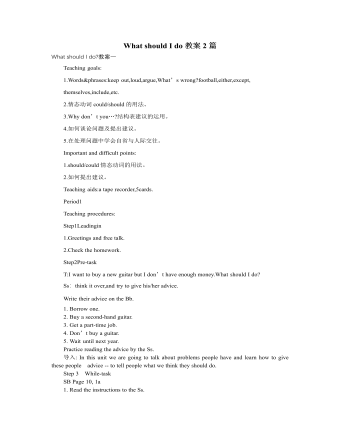
人教版新目标初中英语八年级下册What should I do教案2篇
说明:在帮Li Lei提建议的同时,教育学生如何学好英语。第三课时教学目标1. 语言目标:a) 词汇: Original, in style, haircut, the same as.b) 语言结构:My friend wears the same clothes and has the same haircut as I do.2. 能力目标:大多数学生能够谈论自己喜欢哪种服装,提高查找信息的能力。3. 情感目标:学会如何与朋友相处,要有自己对时尚的看法。教学重点掌握一些重要词汇。教学难点学会谈论问题,并能提出书面建议。◆教学突破首先针对Erin的问题,提出个人的建议,模仿2c部分的对话展开双人交际Pair-work;听老师诵读3a部分的信件,并找出LEFT OUT的问题所在;学生完成3b部分的内容,给Left Out提出书面的建议;学以口头形式提出自己目前存在的某个问题,讲给大家听,让同学们给自己提出一个建议,并作笔录;学生两、三个人分成一组,随意性地进行口语交际,谈论P14的第4部分的某个问题,相互交换意见。
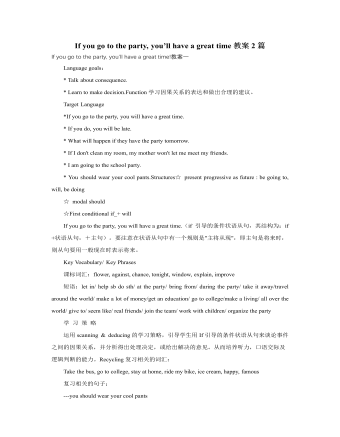
人教版新目标初中英语八年级下册If you go to the party, you’ll have a great time教案2篇
区分宾语从句、定于从句和状语从句宾语从句和状语从句,都叫做主从复合句。宾语从句主要是中考必考的,是初中阶段必掌握的从句,宾语从句主要是掌握三要素,所谓宾语从句,就是宾语在主从复合句当中充当宾语的一个句子,叫做宾语从句。主句的谓语动词是及物动词,后面如果是词或者是短语的话,是简单句,如果是句子的话,肯定是宾语从句。I know that he good at English.就是宾语从句,三要素,一要素是要注意连词,连词一共学了三类连词,一类连词是that口语当中可以省略,就像刚才说的那一句,I hear he is good at English.还有疑问代词、疑问副词,how where when,疑问代词、疑问副词。还有一类连词weather是否的意思,不是状语从句当中的如果,这一定要和如果区分开,这是是否。I don't know if he interested at English。宾语从句要注意if是连词。第二要素是语序,要用陈述举语序。比如说你家有几口人,我们都说How many people are there in you family?但是这是简单句,一旦说成宾语从句,你可以告诉我你家有几口人吗?Could you tell me how many people there are in you family ?





















